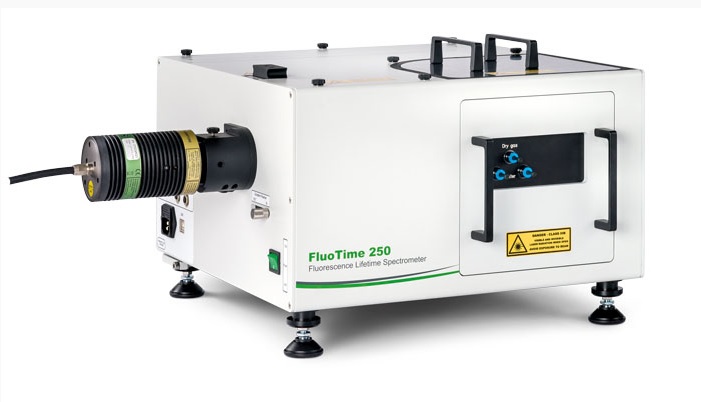
PicoQuant Fluorescence Lifetime Spectrometer – FluoTime 250 integrates all essential optics and electronics for time-resolved luminescence spectroscopy in a compact, fully automated device.
Fully automated compact and modular system
PicoQuant Fluorescence Lifetime Spectrometer – FluoTime 250 integrates all essential optics and electronics for time-resolved luminescence spectroscopy in a compact, fully automated device. This spectrometer is designed to assist the user in carrying out routine as well as complex measurements easily and with high reliability thanks to fully automated hardware components and a versatile system software featuring wizards providing step-by-step guidance.
All components (attenuators, polarizers and filter wheel) in the optical beam paths are motorized and controlled by the EasyTau 2 software. Emission wavelength selection is implemented via a motorized filter wheel equipped with various cut-off or bandpass filters as selected by the customer. An optional monochromator is available for the UV/VIS spectral range.
The FluoTime 250 uses picosecond pulsed lasers diodes and LEDs from PicoQuant’s LDH and PLS series, covering a spectral range from 255 to 1550 nm. All excitation sources are controlled via a PDL 820 laser driver, which allows not only to vary output power and repetition rates (up to 80 MHz) but also supports burst mode for selected laser heads.
Several outstanding data acquisition units are available with various temporal resolutions (from 4 ps to 250 ns). Coupled with the right detectors from the PMA or PMA Hybrid Series, the FluoTime 250 is capable of measuring time-resolved emissions with lifetimes ranging from approximately 10 ps up to several hundreds ms.
The FluoTime 250 can be equipped with a single photon counting detector from either the PMA or PMA Hybrid Series.These detectors offer picosecond temporal resolutions and cover different spectral ranges between 180 and 920 nm. For studies in the near infrared, a PMT module with sensitivity from 950 to 1400 nm is also available. Each detector includes an electro-mechanical shutter, active cooling, and overload protection.
The EasyTau 2 software package is the one-stop solution for both full hardware control of the FluoTime 250 as well as for interactive data analysis and fitting. The software offers a Windows-based graphical user interface with dedicated applications wizards guiding users through the optimization and data acquisition process for many common applications. Advanced users get full control over all instrumental aspects thanks to a customized mode and scripting language. The integrated analysis and fitting module supports a broad range of time-resolved spectroscopy applications, such as fluorescence and phosphorescence decays, or anisotropy measurements. A powerful report generator allows creating presentation-ready graphical and numerical output.
| Optical configuration |
|
| Mode of operation |
|
| Sensitivity |
|
| Lifetime range |
|
| Excitation sources |
|
| Optional monochromator |
|
| Detectors |
|
| Software |
|